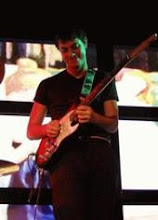Well, all that is true, but still, there are many things that are just too complicated to program which you can easily do with an arpeggiator. There are also many randomizable events that are just impossible to program. In this post I'll show cool things that can be programmed but are easier to do with an arpeggiator. This post assumes you have a decent knowledge of envelopes in live.
Lets get started!
- Now let's start playing with the different parameters ( I won't go into them all):
- Rate - this is the frequency of the notes played for each note fed into the arpeggiator. play around with it a bit and then bring it back to 1/16th which means every note played will be divided into 1/16th note repetitions.
- Gate - the length of the note being played. 100% means that notes will play their full length as set in the rate parameter, in our example, full 16th notes. Setting the gate to 50% will make the notes shorter , in our example, each 16th a short 32th note will be played giving a staccato feel. If set to more than 100% notes will overlap giving a legato feel. very useful for gliding (portamento) sounds.
- Steps - the amount of arpeggiator steps to be executed. With steps set to zero we just have a note repeater, play around a bit and see what happens. Each new note re triggers the arp, so having more than 4 steps will have no effect in our specific example (4 16th notes for each 1/4th note played into the arp).
- Distance - The interval (in semi-tones) of each step set above. If set to +12, for instance, each step in our arp will jump up and octave.
- Style - since we only programmed one note at a time in our midi clip, most of the styles will sound exactly the same, but random will have a nice effect on this one as well. Once you've had your fun , bring it back to UP.
- Now let's set up automation for the first 4 parameters:
- Make a 4 bar looping envelope which plays 3 bars of 1/16th notes, Half a bar of 1/8th notes a quarter of a bar of 1/32th notes and a quarter of a bar of 1/8th notes. Start off by setting the knob manually to 1/32th notes,and in the envelope make 1/16th notes +2 and 1/8th notes +4. starting to sound cool already huh?
- Make a 3 bar looping with a simple up and down pattern for the gate parameter. manually set the knob to 135% (this will define the peak of the envelope):
- set the steps knob to zero manually. then build a 5 bar envelope setting the value at +4. In draw mode set each 1st quarter to a different value:
- set the distance knob to zero manually. Then build a 1.5 bar loop with a +7 and +10 distance somewhere in the middle :
With 5 minutes, a bit of tweaking and minimal imagination, we took a really dumb loop and made a cool (almost) random feeling loop out of it. Try changing the simple operator patch into something cooler or better yet, add more automation to the SW synth and see how far you can take it!
Wanna contribute a cool tip?
email me : fireballgames AT hotmail DOT com
Feel like being a good sport?
Add me as a friend on myspace!
Cheers
J







That's a nice tutorial bruv! :)
ReplyDelete